April 29, 2007
Seattle blogger sounds poison alert
Seattle political writer David Goldstein at a community forum in Belltown two weeks ago.
The overnight blogs are abuzz: Tenet (slamdunking Iraq) and Goldy (recycling poisoned pet food).
Both merit close attention, but Goldy (David Goldstein) is right here in Seattle, and he's making international news. Let's not forget that his blog, HorsesAss.org, was the first to reveal Michael Brown's bogus credentials to run FEMA. This time, it's another fuckup, but with truly ominous potential: China's melamine-laced pet food was recycled as feed for domestic pork, and our FDA let them get away with it.
Cornichon took some heat last year for straying off-topic and discussing food safety. Tough shit. We trust the gummint to keep unsafe food off the market. If the incumbent administration's public policy falls short, we've got to speak up.
Who knows what kind of shit is adulterating our imported and domestic food supply? But whatever it is, it's about to hit the fan.
The FDA, says Goldy, must have known that this wasn't, um, kosher.
Had this accident never occurred -- had cats, with their sensitive renal systems, not been the canary in the coal mine of melamine toxicity -- we might never have known that our children and our pets were being slowly poisoned by Chinese capitalism.
The blog DailyKos, reporting on Goldy's revelations, concludes:
Did the FDA know that the Chinese were spiking rice, wheat, and corn gluten with melamine, a chemical that boosts nitrogen levels, what food regulators commonly test to determine protein levels? It seems likely. So now the question, why did they let it continue for so long?
The frightening conclusion: it's not just Fluffy's and Fido's food dish, it could mean that virtually every plate in the country ends up contaminated. Let the finger-pointing begin.
April 28, 2007
Hot date
How to tell Jon Rowley's dating service from Deborah Jean Palfrey's:
Business entity
• Palfrey: Pamela Martin & Associates
• Rowley: Taylor Shellfish Farms
Business activity
• Palfrey: as DC Madam, offers adult fantasy service
• Rowley: as lifestyle guru, offers sensory compatability research
Client base includes
• Palfrey: Department of State
• Rowley: Department of Ecology
Operating environment
• Palfrey: hot water
• Rowley: cold water
Locations include
• Palfrey: Washington DC
• Rowley: Washington coast
Physical characteristics
• Palfrey: (one assumes) soft, clean
• Rowley: crisp, clean
Services involved
• Palfrey: hookers
• Rowley: bivalves
Latest news
• Palfrey: former client resigns as assistant Secretary of State
• Rowley: announces best wine-oyster matches for 2007
Sluurp!
April 27, 2007
Modest proposal
In Chicago, the food police are throwing people in jail for serving foie gras because it comes from obese geese. Elsewhere, they're trying to get rid of junk food in schools because it causes the kids to become obese.
Meantime, there's a new, flexible tube that's supposed to make gavage (French for "fattening up") less painful.
I say put the damn hose on the vending machines down at the high school. Pilot program at Garfield, maybe. You fork over a couple of bills to the Lunch Lady and the machine grinds up a tasty mash of Twinkies, Snickers, Ruffles and Diet Pepsi. Glug-glug, gulp-gulp, and you waddle off to class, happy as a clam.
April 26, 2007
The wines of Covey Run
Covey Run, which began life 25 years ago as Quail Run in a spectacular winery with a four-star view from its Whiskey Canyon Vineyard overlooking the Yakima Valley, is now part of the world's largest beverage conglomerate, Constellation Brands. Sure, it's "sad" that you no longer have family ownership (even the founders company, Holtzinger Fruit, has been taken over by Intracorp Capital), but this is a good example of the advantages of corporate marketing.
Covey Run now concentrates on a specific segment: the market for wines priced under $10. And for all of the hyperbole about winemaker Kerry Norton "crafting" the wine, it's the quality of those Yakima Valley grapes that makes these wines possible.
A corporate marketing budget also lets the PR department send samples out for review. A box of Covey Run appeared on the doorstep this week, with technical notes and suggested food pairings. Time to go shopping and make dinner!
Menu, tasting notes and a recipe follow.
Chenin Blanc: our aperitif, bright, crisp, not too sweet, paired well with slivers of asiago cheese.
Sauvignon Blanc was something of a failure with freshly shucked Hamma Hamma oysters (too flabby), but a real delight with seafood linguine. Maybe it was because we deglazed the sauté pan with it?
On the other hand, we dind't find the Pinot Grigio particularly impressive, on its own or with the pasta.
To test the three reds, we broiled lamb chops in a coating of mustard, rosemary and garlic, accompanied by stuffed tomatoes and fresh asparagus.
Syrah was the standout, with its own flavors of black pepper complementing the lamb. Lemberger was soft and pleasant, while the Cabernet Sauvignon seemed overly tannic by comparison.
For dessert we whipped up a Sicilian cheese torte: equal parts ricotta and goat cheese, a couple of eggs, some sugar, a bit of lemon juice and orange zest, and baked it in a pie tin for about an hour at 300 degrees. It made a terrific foil for the final wine, Morio-Muskat, and allowed its flavors of tangerines and peaches to shine.
Consensus scored the Morio-Muskat highest, something of a surprise for a wine that retails for $8. The Syrah was second, at $13. All the other wines carry a suggested price of $9.
In theory, this means they should be about $20 on a restaurant wine list. Wouldn't hesitate to order any of them.
Thanks to Dr. Joe for hosting!
April 25, 2007
500 Wineries in Washington!
Yes, sonny, there was a time, less than 25 years ago (don't giggle!) that you could write a whole guidebook to Washington wine and list only 37 wineries. I should know, I typed every word of the goddamn thing myself. Ah, just look how young we were in 1983:
• Page 1: "wine touring ... a new concept"
• Page 5: "Are all these new wineries going to make it?"
As it turned out, of course, very few failed. And when the state liquor board officially licenses Sweet Valley Wines of Walla Walla this week, the number of wineries in Washington will reach 500. In the days since Touring the Wine Country of Washington was published, vineyard acreage and harvest tonnage have quadrupled, and everyone (except the business editors at the Seattle Times, who embarrassed their own wine writer with this report) recognizes that Washington wine is where it's at.
Oh, by the way: Alibris has 28 copies of the book left, Amazon has 22, starting at one penny, plus shipping.
April 24, 2007
We are what we grow
There's no clearer voice in America about the business of food than Michael Pollan's. In The Omnivore's Dilemma and subsequent articles for the New York Times he brings both passion (for fresh, local ingredients) and clarity (the result of feet-on-the ground research) to the table.
His latest piece reminds us that the Farm Bill is one of the country's most important pieces of social engineering. Up for renewal shortly, it sets the broad outlines of American agricultural policy, subsidizing just five commodity crops (corn, soybeans, wheat, rice, cotton), thus determining what gets grown where.
This subsidized overproduction puts cheap processed food on supermarket shelves (so poor people often eat unhealthy diets) and cheap corn- and soy-based exports that undermine agriculture in developing countries (often forcing Latin American farmers off the land to seek work in the US).
To read the full article, click here. It's a complicated story, well worth digesting.
April 21, 2007
Goodness grows on the Internet
This has only been around for a couple of months (but catching on quickly): a website called GrowingGoodness that aggregates videos about farmers markets and sustainable agriculture:
Comes with a regular blog as well as a video blog; contributions encouraged, directly or as Flickr and YouTube links.
The overall mission is to create more public awareness and interest in local farmers markets, always a good idea!
Kinda wish the lead video for Seattle wasn't, once again, the dudes heaving fish at the Pike Place Market. And kinda wish the "secrets of winemaking" video were from Oregon or Washington instead of Colorado (where they have to buy their cab and zin grapes). But then, the whole database is only a few weeks old and it's growing fast.
The breadth of the video profiles is certainly encouraging. And it's wonderful to see links to great websites from places like the Ferry Terminal Farmer's Market in San Francisco and blogs like I Heart Farms. Ties in, too, with Staci and Craig's video project, The People Who Feed Us.
Nature and Wildlife Tours - Order FREE Travel Brochure!
April 20, 2007
The Baker
Times are good for folks with new Italian restaurants (Sorrentino, Tavolata, Barolo, La Spiga, Bèato): lively, fiercely independent, stamped with the vibrant personalities of their owners. And then there's the local outpost of Il Fornaio at Pacific Place, a chain that's been around for years, putting its own stamp on regional Italian cuisine with a monthly "culinary festivals."
The fornaio is Italy's baker, and crusty, fresh-baked bread is indeed one of the restaurant's signatures. (The company started as a bakery school outside Milan 35 years ago.) Wine's important, too, with monthly tastings in the soaring atrium of Pacific Place and house pours cheerfully decanted from mini-carafes in the dining room. Last night it was grechetto, a white from Umbria (called grey riesling in California) that made a sprightly aperitivofor a "regional sampler" media dinner.
Primi piatti featured potato gnocchi in a lamb ragù (from the Veneto) alongside ravioli filled with grilled pears and mozzarella (Tuscany). Secondi were halibut baked with pine nuts, olives and raisins (Sicily) and the star of the dinner, braised rabbit over polenta (Trentino). By this time we were on to the Marco Feluga Molamatta (Friuli) and Banfi's reserve Chianti.
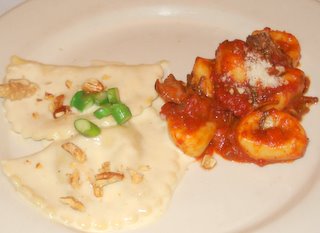
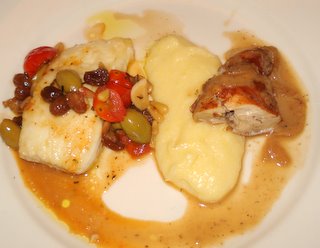
The kitchen is run by chef-partner Franz Junga, who also teaches classes. Next class: the Veneto, May 12th; next regional Festa: Puglia, May 7-20.
Il Fornaio, 600 Pine St., Seattle 206-264-0994

Europe Vacation Packages - Order FREE Travel Brochure!
April 19, 2007
What a friend we have in cheeses!
Blasphemy or verity? Does it matter that the cheeses were all French? That the venue for this six-course cheese-eating dinner was the venerable Mitchelli's in Pioneer Square? That the guest of honor was Lou DeLaurenti?
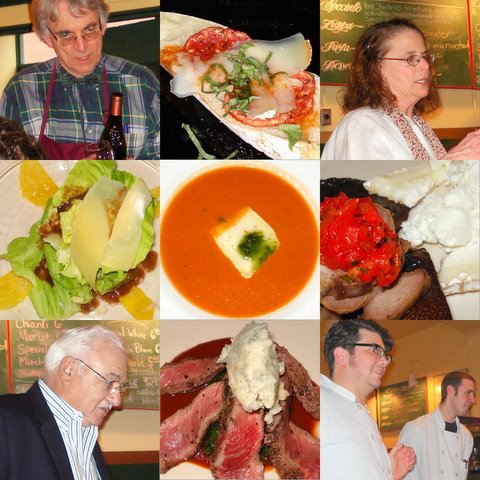
All God's ungulates get in on the act. Sheepish Ossau Iraty on bruschetta to start, followed by mountain-milky Comté shavings on a salad of Boston bibb and golden beets, then Calvados-washed Grain d'Orge surrounded by tomato bisque. Moving on, a goaty Bûche Maître Séguin with smoked lamb tongue and roasted portobello; cave-aged blue-veined Roquefort atop a flatiron steak; cream-infused Délice de Bourgogne with a mocha pot de crème, all matched up with four fine wines.
In the end, verity trumps blasphemy, washes away sins, grief, needless pain. Besides, Mitchelli turns 30 this year! Thirty!! A friend indeed.
Mitchelli's, 84 Yesler Way, Seattle, 206-623-3883
Europe Vacation Packages - Order FREE Travel Brochure!
April 18, 2007
Eatin' in the 'hood
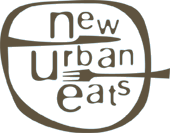
What fun! Another restaurant promotion! This one's called New Urban Eats, and it features 20 relatively new places offering three-course dinners for thirty bucks. Sunday through Thursday, throughout May except (wonder why?) Mother's Day...the one day nobody should eat out but everybody does.
Sure, there are plenty of perfectly lovely places that serve dinner for less than $30. But the NUE restaurants are kinda fancy, kinda pricey, kinda hot. In some cases, very fancy, very hot. Predictable names (Steelhead Diner (that's Chef Kevin Davis, showing off his vegetarian meatloaf, above), Qube), geographically diverse (Sip and Iris in Issaquah! Who knew?), and what I call the "CR3 crew" (Crow, Crush, Crémant).
The long-established, March & November "25 for $25" promotion set the standard. Cooked up by Rich Malia (Ponti), Chris Keff (Flying Fish), Allan Aquila (Yarrow Bay Grill), Maureen Shaw (Ray's Boathouse) and PR guru Lissa Gruman, they faced enormous odds recruiting participants. "Can't make money, not our customer, don't want to play with those guys, etc." Early players took a leap of faith; Seattle restaurants hadn't tried anything collaborative like this before.
"We didn't really expect 25-for-25 to grow as successfully as it has," Gruman recalls. As for the magic "25" number? That was all the original group could round up.
Wasn't until later that you'd hear periodic grumblings from newcomers like Ethan Stowell, who wasn't around at the start and considered himself locked out of the club. For all that, neither of Stowell's restaurants, Union nor his controversial new spot, Tavolata, is on the NUE list, either.
NUE is giving newer, smaller, independent restaurants a chance to shine, but they still had to be well-reviewed by the dailies. Sounds fair, and we know how fickle they can be.
(Parenthetically, it's no accident that this year's Pulitzer for criticism went, for the first time, to a restaurant writer...not for a daily (Ruth Reichl never won when she was at the Los Angeles Times) but for the scruffy, wildly talented critic at an alternative urban rag, Jonathan Gold of LA Weekly.)
Nice touch on the NUE website: menus for all participating restaurants. Scallop sashimi at O/8, duck liver flan at Crémant, the unctuous lamb shank at Crow, Olympic Mountain ice cream at 94 Stewart. Hardly know where to start.
Food, Wine Tour Packages and Cooking Schools - Order FREE Travel Brochure!
April 17, 2007
Watching cheese dry
Somebody needs to get a life. Almost a million people have tuned to a webcam called CheddarVision that stars, you guessed it, a 44-lb. wheel of cheddar. There's not a lot of action, frankly. A digital clock counts the milliseconds; you can click over to YouTube for the time-lapse version.
Eventually you might be sufficiently intrigued to buy some cheese online. More helpful, perhaps, to see the real thing in person, whether cheddar in the West Country or Parmigiano-Reggiano in Italy, where they soak the cheese in brine for a month before the aging begins.
Food, Wine Tour Packages and Cooking Schools - Order FREE Travel Brochure!
April 16, 2007
Mouthpiece for local food
Will never forget the rain-drenched trip to Burgundy with documentary filmmakers Staci Strauss and Craig McCord in November, 2000: the season of Florida's hanging chads.
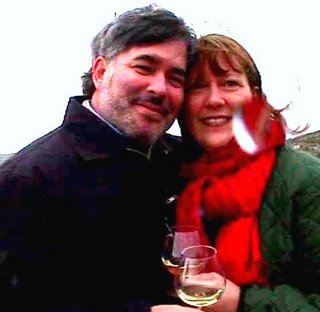
Eventually they moved from New York City to Woodstock; Staci started an online clothing company called FoodGoods; Craig ran a photography blog, Small Bites.
Just got word that they've launched a foodie website, The People Who Feed Us. It's terrific! Craig says he wants to be the mouthpiece for local food. Go for it!

Food, Wine Tour Packages and Cooking Schools - Order FREE Travel Brochure!
April 15, 2007
There's wine in Washington!? You're kidding, right?
Time to shake our collective heads. Anyone with half a glass and half a brain knows there's terrific wine in Washington. Chateau Ste. Michelle has been an industry leader for over two decades; we've gone from a handful of wineries to 500 licensed producers since 1980; we're the envy of the growers worldwide. But that obviously excludes the business staff at the Seattle Times. They can't even run a google search on their own content.
Just look! With enormous fanfare this weekend, the paper trumpets the arrival of a cult winemaker from California, Randal Grahm, in our "mostly overlooked" region.What? Just because a quirky guy from Santa Cruz is setting up shop in Benton City, it's front-page news? What about the international awards (reported on this very site from time to time) garnered by folks who've lived here all their lives?
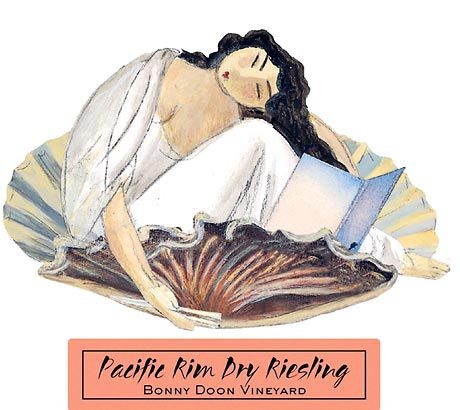
If we were Paul Gregutt, the witty and perceptive wine writer whose columns appear weekly in the Times, we'd take up arms against the business department. Don't these guys ever read their own freaking paper? "Mostly overlooked," my glass! And they wonder why newspapers are becoming irrelevant.
![]()

Food, Wine Tour Packages and Cooking Schools - Order FREE Travel Brochure!
April 13, 2007
Dry up!
Dry Soda continues Seattle's tradition of tastemaking beverages. Started, in a sense, with Chateau Ste. Michelle wine, some 30 years ago, moved on quickly to Red Hook beer and Starbucks coffee. Even Thomas Kemper root beer and Jones Soda. Now, another homegrown entry in the hot category of Adult Non-Alcoholic Specialty Beverages.
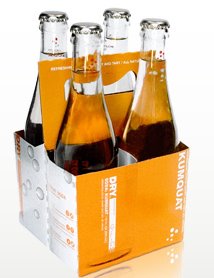
Comes word that Readers Digest is naming Dry Soda to its "Best of America" list in the May issue, calling it a hidden gem. Says Dry Soda's founder Sharelle Klaus, "I wanted something that wasn't sweet." The first four flavors (kumquat, rhubarb, lemongrass, lavender) were inspired by her garden, with only a little pure cane sugar added.
Dry Soda, 410 1st Ave. S., Seattle, 206-652-2345
April 10, 2007
Cheese Man
He's best known as the owner of Beecher's Handmade Cheese in the Pike Place Market, but keep in mind that Kurt Dammeier is an entrepreneur, a guy who loves doing business deals. Increasingly, those deals revolve around his passion for natural ingredients and pure food; with evangelical fervor, he stages comparative tastings to spread the gospel of artisan cheese.
At a seminar aboard a Holland America cruise, Dammeier teaches Cheese 101.
Dammeier made a fortune when his family's high-tech printing company was acquired by a Canadian rival in 1994; with the proceeds, he started investing. First came Pyramid Breweries, where he served for a time as chairman of the board and opened the popular Alehouse across from Safeco Field. Next he acquired the four Pasta & Co. stores, founded by Marcella Rosene, which had established a reputation for high quality ingredients. Couple of years ago, he launched Bennett's Pure Food Bistro on Mercer Island, because that's where he lives and he wanted a good restaurant nearby.
For its part, Beecher's occupies a central spot in the Market, long the home of the Seattle Garden Store. To snag the coveted space, Dammeier couldn't just put in another Pasta & Co. outlet; the Market watchdogs frown on chain outlets. (Starbucks is exempt because it started in the Market.) But an artisan cheese factory? Well, yeah, that was a concept the Development Authority could go for. And Dammeier, a 1982 grad of Washington State, had been aching to produce a cheese of his own ever since he discovered Wazu's award-winning cheddar-in-a-can, Cougar Gold.
Then, instead of the usual steps (raw materials, manufacturing, distribution), Dammeier put the deal together backwards. He had the sales outlet and the basic concept in hand; now he went looking for a production guy, a cheesemaker. And he found Brad Sinko, whose own family operation on the Oregon coast, Bandon Cheese, had just been snatched up by Tillamook. Together, Sinko and Dammeier went looking for a dairy to supply the operation. They found what they were looking for at Green Acres Farm in Duvall. The herd was originally all-Holstein; now they've added an equal number of Jerseys. Worth noting that Green Acres doesn't own the 40 new cows; instead, it leases them from a local entrepreneur, who just happens to be Kurt Dammeier.
France has hundreds of traditional, regional cheeses; not so in the US. Dammeier set out to create a specifically local cheese for Seattle. He and Sinko quickly settled on a cheddar-Gruyère hybrid; they named it Beecher's Flagship--Beecher was Kurt's grandfather--but it would have to age almost a year. While they waited (and the raw milk version was particularly promising), they built up an 80,000-pound inventory...and sold a lot of fresh curds. Dammeier also perfected a pasta recipe, "World's Best" mac & cheese," that's now shipped nationwide. That's the one he cooks up for guest shots on TV; it's rich, creamy and utterly delicious.
Should add that Dammeier has a cookbook called Pure Flavor coming out in late July. Can't wait!
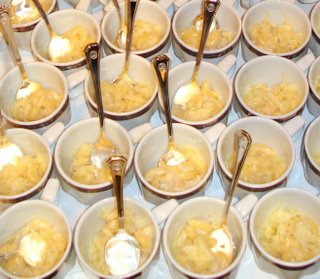
Dammeier cooking on closed-circuit TV; sample cups of mac & cheese
April 8, 2007
An orphan wine, a fruit plate
Interesting wine being poured on this Holland America "Wines of Washington" cruise: Chateau Ste. Michelle's Orphelin. (That's French for orphan). It's a blend of nine international varieties including the Rhone (syrah, mourvèdre, cinsault, grenache), Italy (sangiovese) and Portugal (souzao, touriga) plus (to "round it out" for the American palate), cab sauv and petit verdot. Would be tempted to call it Kitchen Sink except that it's really tasty and great with both fish and cheese.
The winemaking staff basically blended a bunch of "orphan" barrels, small lots of wine that wasn't going into any of their other products. Offered to members of Ste. Michelle's Vintage Reserve Club last year, the wine carried a $40 price tag and sold out so fast it never reached the general public. The 2004 vintage will be released to the restaurant trade later this year, aimed at the high-end, by-the-glass market.
For its part, Holland America puts a lot of effort into the look and feel of its cruise experience. In the upscale Pinnacle Grill of the ms Zaandam, for instance, the plates are Rosenthal's Bulgari pattern. So, what are the five fruits on the design? (Hint: one's a lemon.)
First set of correct answers wins dinner for two at the Art Institute of Seattle's Portfolio Room.
April 6, 2007
All at sea
Cornichon is taking time off from the boulevards in favor of a Holland America cruise aboard the ms Zaandam. A wine cruise, to be sure. Wines of Washington, in fact: Chateau Ste. Michelle, Hedges, Gordon, l'Ecole No. 41 all ably represented.
First time aboard a cruise ship! It's a floating village: 1,400 guests, 600 crew. Two city blocks long, 10 decks, 18 elevators, restaurants, cafés, bars, pools, meeting rooms, casino (poker, blackjack, slots), shops, theater, tennis court, gym, spa, more bars.
Above: Zaandam sommelier Fernando Bacsa presents CMS White, Chateau Ste. Michelle culinary director John Sarich. Below: Crab timbale at dinner, crab with avocado at culinary demo. Coincidence, coincidence!
Before all else, lifeboat drill. Might seem like waste of time, but this morning's news brings word of a Greek cruise ship sinking (sinking!!) in the Mediterranean and an unfortunate "incident" involving another cruise ship out of Florida. Gulp and double gulp! Well, gotta go: still some bars to discover on this seagoing boulevard.
Queasy at the prospect of abandoning ship.
April 5, 2007
Wish upon a star
German lottery called 5 Sterne lets winners of the million-euro grand prize to pick their own payout: house, yacht, land, annuity. Your choice. Below left, an example of the traditional ad pitch:
But what if you're "disabled" and in a wheelchair? Would you pick the yacht? Well, why the hell not? Loved this not-so-subtle reminder that most of the barriers in this world are artificial.
On the other hand, lotteries always seem to target the disadvantaged, don't they?
April 4, 2007
Expat with dog
Patricia Laplante-Collins, born in Atlanta, embraces the hand life has dealt her: professional expatriate. From Sarah Lawrence to Italy to France, she's moved in unexpected directions. Eight years ago she started Paris Soirées, opening her apartment to foreign visitors and introducing them to local culture at twice-weekly dinners and cocktail parties.
Lunch at a delightful, funky bistro on the Ile St. Louis, around the corner from Patricia's old apartment. Patricia arrives accompanied by her black lab, Eve, who enjoys the status of Honorary House Dog wherever she goes.
If she'd stayed in Atlanta, Patricia would probably have ended up with a perfectly decent middle-class career, a family and a house with a picket fence in a leafy-green neighborhood. Instead, she's in Paris, with a devoted following of artists and intellectuals, not to mention an amazing dog, at the very summit of western civilization.
To get on the list for one of Patricia's soirées, call her at 01 43 26 12 88 in Paris or send an email to ParisSoirees@gmail.com.
April 3, 2007
The Weisswurst tradition
Nothing's more Bavarian than a breakfast of Weisswurst. It's a delicate, very perishable sausage made early in the morning with finely ground veal, pork and mild spices; heated in barely simmering water; served and eaten before noon with sweet mustard and soft, doughy Brezn. Of course you drink the cloudy, slightly fruity wheat beer called Weissbier.
That's your zweites Frühstück here at the beer halls in Munich, where your table companions are pensioners and local businessmen indulging in their traditional second breakfast. (The tourists will come for dinner; right now, they're out in the Rathaus square gawking at the Glockenspiel.) You slice the sausage lengthwise and pull it away from the skin. Minimum order is two, but it's considered unlucky to eat an uneven number. So give in to superstition, already! You can skip lunch and make a mid-afternoon pastry stop instead, right? Another excellent German tradition.

April 2, 2007
Asparagus International
A full moon in Munich to herald the arrival, finally, of spring! Asparagus sprouts suddenly everywhere: in markets, on menus. Green from Greece, white from Spain, served with pride and a goodly dollop of "Dutch sauce" (Hollandaise) in the beer halls.
Price is steep enough, about ten bucks for a half dozen exquisitely tender stalks, worth every penny. Such a pleasant change from the weedy, woody asparagus we get in Seattle, imported from Peru. Globalization: Yakima Valley farmers can't compete with South America's lower labor costs.
UPDATE: three or four Spargel sellers in the Altstadt today have added the first locally grown, hothouse asparagus. Price is 10 euros per kilo (about $6/lb), double the rate for imported.
Heading back to Paris shortly. Will see if the glorious white asparagus from Argentueil has made it to the markets. Hmm. Might have to wait around another couple of weeks ...
Marienplatz, München
April 1, 2007
Climb Ev'ry Poundcake
Salzburg: you hear music right away, the hills alive with Edelweiss, as it were. It's in your head, but you can't shake it; Salzburg is the City of Music, after all. Local boy Amadeus has a handsome bronze statue and his picture on chocolate boxes but American fans of The Sound of Music keep three tour companies in business.
Most locals remain blissfully unaware of the problem named Maria. Everyone crowds into the Getreidegasse, jostling the endless displays of souvenir Mozartkugeln, then hangs out at the formal, wood-paneled Café Tomaselli. Looks unchanged since the dawn of time. A stout lady comes by with a tray of pastries; a tuxedo-clad waiter ("Herr Ober") takes your order for drinks. The Einspänner is strong coffee topped with whipped cream.
Kaffee und Kuchen at Cafe Tomaselli
The other famous café is Demel, all modern inside, snappy website, buzzing young crowd, fabulous view over the Mozartplatz. Wonder whether Mozart would have approved.
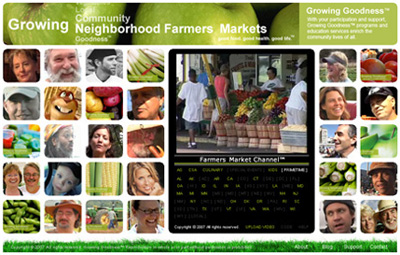
 "
"